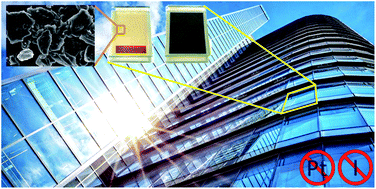Platinum-free photoelectrochromic devices working with copper-based electrolytes for ultrastable smart windows†
Abstract
Photoelectrochromic systems are devices designed for large-scale manufacturing of smart windows, capable of changing their transmittance according to external environmental conditions. This communication proposes the replacement of the two most critical photoelectrochemical device components studied so far, namely the counter electrode and the redox mediator. Regarding the first, graphene nanoplatelets are used to replace platinum, maintaining both its optical and electrocatalytic properties, and at the same time reducing the device cost. Secondly, a copper-based redox pair was chosen to solve the corrosion problems typically encountered with the iodine-based mediator. The combination of the above components led to devices with high performance (coloration speeds in the order of seconds, with a maximum contrast ratio of 10.4 : 1), as well as the achievement of a long-term stability record (over 400 days) for these photoelectrochromic systems.

- This article is part of the themed collections: 2022 Journal of Materials Chemistry Lectureship shortlisted candidates and Journal of Materials Chemistry A Emerging Investigators


 Please wait while we load your content...
Please wait while we load your content...